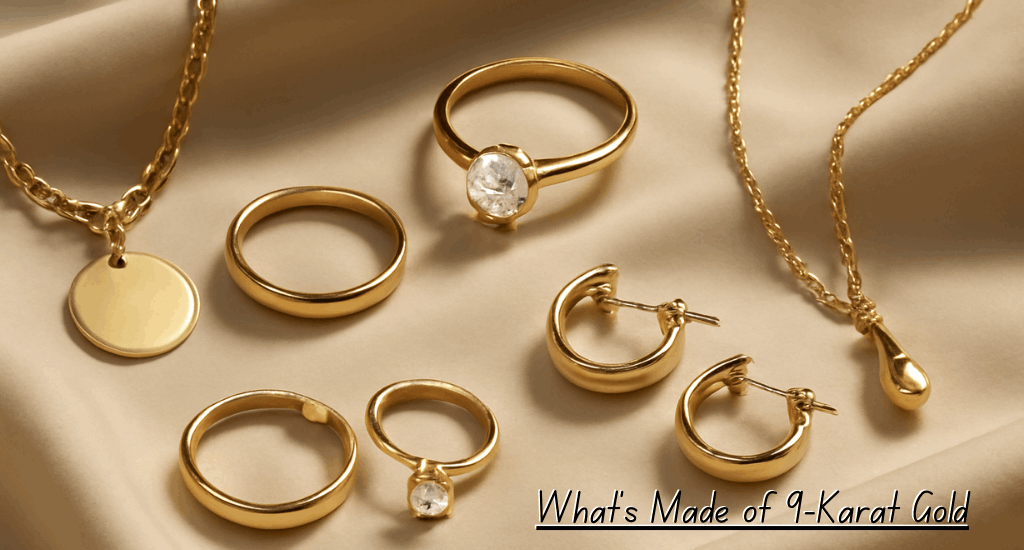Short Disclaimer: This post may contain affiliate links at no extra cost to you. Visit our Disclaimer Page for more details.
Understanding the various types of precious metals can be confusing, especially when buying jewellery.
Among all purities, 9-karat gold is a popular choice that is both affordable and attractive, while also being durable.

This guide will explain everything about what is 9kt gold means. So you can make a smart jewellery purchase for your occasion as well as an investment.
1. What is 9kt Gold? The Composition Behind the Beauty.
9-karat gold contains exactly 37.5% pure gold, with the remainder being other metals such as copper, silver, and zinc.
This specific alloy composition provides notable properties for those of high-purity gold, including increased durability and a touch of modified colour.
Yellow gold is usually a mix of 37.5% gold, 42.5% silver, and 20% copper.
That’s the classic recipe, but people like to tinker, you know? If you want pink gold—think rose gold for that trendy Instagram look—it’s got way more copper (like 42.5%) and less silver (about 20%). That’s what gives it that rosy glow everyone’s obsessed with.
White gold? Totally different vibe. It’s still got the 37.5% gold, but then you throw in a hefty chunk of silver (62.5%) and, boom, you get that cool, silvery finish. Makes you look fancy without going full platinum.
And these ratios? Not just some random guesswork. Jewellers use math to make sure the stuff doesn’t fall apart on your wrist but still looks killer.
But to give high-sign finished on products, manufacturers are using rhodium.
2. Durability: Why 9-Karat Gold is Best for Daily Wear.
One of the biggest advantages of 9-karat gold jewellery is its impressive durability.
It’s tougher than higher-Karat gold because it contains a higher percentage of alloys.
Let’s compare it to 24-karat gold: – 24-karat pure gold: It’s soft, scratches easily, and isn’t the best choice for everyday wear Jewellery.
9-karat gold: It’s more resilient, stands up to scratches and wear, making it ideal for daily use.
This durability makes it a fantastic option for engagement rings, wedding bands, and everyday pieces.
So, why do jewellers often suggest 9-karat gold?
Many professional jewellers recommend it for those with an active lifestyle and lighter jewellery. It strikes a great balance between the strength of alloys and the beauty of gold.
While it may be a touch lighter in colour compared to higher-karat gold, you probably won’t even notice the difference in your day-to-day life.
3. Real Gold, Real Easy to Acquire.
The biggest advantage of 9kt gold jewellery is still the price. Today, 24KT (999) gold is priced at ₹10,088 per gram in India as per IBJA, so 9K base metal works out to be around ₹3,783 per gram (excluding making charges and GST).
Remember, Prices vary by region in international markets. In the UK, 9K gold is priced at £27.6 per gram (scrap buyer quotes), and metal-equivalent calculations come to £30.2 per gram. Calculate 9K $40.8 per gram (24K $108.9/g) from spot for US markets.
4. Perfect fit for every category of jewellery.
9-karat gold is versatile – meaning it fits into almost every category of jewellery. Its strength makes it easy to create pieces with intricate designs, stone settings, and detailing. This alloy is perfect for:
- Daily wear jewellery like chains, bracelets, and rings that can be worn daily.
- Bold statement pieces where the shape and structure must remain strong.
- Office-wear jewellery that gives a professional look.
- Kids’ jewellery where durability is of utmost importance.
- Its flexibility gives jewellers the option to create both traditional and modern designs. Additionally, you retain fine details and remain strong over time – a reason many jewellers prefer 9k gold.

5. Friendly for sensitive skin
If you have a little sensitive skin, 9-karat gold can be a good choice for you – the only condition is, the alloy must be nickel-free. Nickel is the main culprit for most jewellery allergies.
Good quality 9k alloys are usually made of copper, silver, and zinc, and these metals are very rare to cause skin reactions.
Meaning if you are irritated by other metals but love wearing gold jewellery, this is a safe bet.
Just remember to always buy from trusted jewellers who clearly mention the alloy composition. Cheaper versions may contain irritating metals.
And if you already have metal allergy issues, it is best to verify the composition once, and if in doubt, do a patch test.
6. Less care, more lifespan.
This gold jewellery is strong, but because it contains more alloys, it can tarnish a little faster.
The good news is that a little care will keep your jewellery shining for a long time.
Easy Care Tips: Wipe with a soft, dry cloth daily.Removes sweat and oil. Soak in warm water, mild soap once a month, clean gently with a soft toothbrush.
Always keep jewellery in individual pouches or soft cases available in stores—no stress of scratches.
Don’t remove jewellery while swimming, bathing or cleaning—chemicals can cause the shine to fade quickly.
Regular cleaning not only maintains the shine but also slows down tarnishing. And yes, get it professionally cleaned once or twice a year—the jewellery looks like new again.
7. Investment angle and market views.
Now let’s talk about money. 9-karat gold has its own price, but for investment, it is a slightly different game.
It contains approximately 37.6% pure gold, so its price also has a huge difference from pure gold.
Nine karat gold price alwoys aprox 68% lower than pure gold. Meaning, the fluctuations in the gold market have a less direct impact here.
The current price of nine-karat gold in the UK is around £30.26 per gram. Buyers usually pay up to 90-95%, depending on the quantity and condition.
If you are looking to buy gold only for investment, then higher karat gold is better.
But if you are looking for jewellery, then nine-karat is a great option.
It holds much more value than gold-plated jewellery because of the real gold content. Meaning jewellery is stylish and an asset too
Making smart choices
What is 9kt Gold? We understand from the above content. Nine-karat gold is a perfect mix of luxury + durability + affordability.
It has the charm of real gold, and the alloy mix makes it wearable on a daily basis.
Whether you are buying your first piece of gold jewellery, need durable pieces for an active lifestyle, or are looking for pocket-friendly luxury, 9-karat gold is a solid choice.
At a time when pure gold rates are skyrocketing day by day, 9-karat gold has become a practical and stylish option that is becoming everyone’s favourite.
Bottom line: If you choose wisely and take a little care, 9-karat gold jewellery will give you long-lasting shine, value and happiness.
FAQ
-
How does 9 kt gold differ from 14 kt or 18 kt gold?
Strength: While 9kt gold offers greater hardness and scratch resistance, 14kt and 18kt are softer alloys that typically retain their value and beauty longer in antique-quality jewellery.
Purity: 9kt content 37.6% pure gold. 14kt content 58.6% gold and 18kt content 75% gold.
Colour & Aesthetics: The colour appears lighter and less golden due to the reduced gold content when compared with higher-purity alloys
-
Is 9 kt gold suitable for daily wear?
The added hardness makes these items comfortable for everyday wear, such as rings and chains.
However, some experts note that being harder can also mean breaking a bit more quickly, which could impact its long-term durability compared to 18kt pieces of gold.”
-
Is 9 kt gold hypoallergenic?
The suitability of 9K gold for sensitive skin depends largely on the metals it is alloyed with—hypoallergenic blends such as silver or palladium are generally safe. In contrast, alloys containing nickel or copper may cause irritation or discolouration.
The composition of 9K gold contains only 37.6% pure gold, with the remaining 62.4% being a mixture of alloy metals such as silver, copper, nickel, or zinc. This higher percentage of alloy metals directly affects its skin compatibility.
-
Does 9 kt gold tarnish?
Yes, due to its higher alloy content, especially in white or rose 9 kt gold. Regular cleaning can help minimise tarnishing.
-
Is 9 kt gold legally recognised as “gold” in different regions?
Yes, in the UK, Ireland, and Europe, low-purity gold is freely sold with the government’s permission.
However, the US does not recognise 9 karat gold. It does not legally allow any gold jewellery below 10 karats.
India has also been approved by BSI recently. -
How should I care for 9 kt gold jewellery?
Clean with warm water, mild soap, and a soft cloth
Avoid harsh chemicals
Store in a soft pouch or jewellery box to reduce scratches. -
Is 9 kt gold a good investment?
It’s an affordable, durable option—great for fashion trends, everyday wear, or new collections. But for long-term value appreciation, 24Kt, 22Kt, or 18Kt is considered an investment.
-
Is 9kt Gold Safe for Kids?
If your child has very sensitive skin, consider higher karats (14kt or 18kt) or medical-grade titanium/stainless steel instead of 9kt gold.